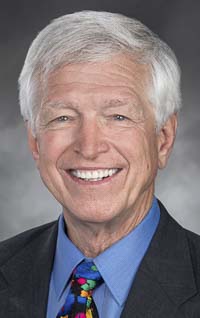
Rep. John Ley opposed the bill in committee on Monday; He said he’ll propose changes when it reaches the House floor for a vote
Jerry Cornfield
Washington State Standard
Washington state lawmakers on Monday backed a huge increase in the amount of toll revenues they’ll count on to help pay for construction of a replacement bridge on Interstate 5 across the Columbia River.
The House Transportation Committee amended then approved House Bill 1958, authorizing the sale of $2.5 billion in general obligation bonds. That’s $900 million more than assumed in the original bill. The legislation now goes to the Rules Committee and a likely floor vote in the coming days.
With significant cost increases on major highway and bridge projects in recent years, it made sense to recalibrate to a higher bonding capacity to avoid getting into a pinch, backers said.
“The idea is that we have to have enough resources for construction. We think we have enough, but we want to make sure,” said Rep. Jake Fey, D-Tacoma, chair of the House Transportation Committee and the bill’s sponsor.
Sen. Marko Liias, D-Edmonds, chair of the Senate Transportation Committee, said, “We need to make sure this project is well-positioned to stay on schedule and get built as soon as possible.”
Project planners have estimated the price tag for replacing the bridge will range from $5 billion to $7.5 billion, with a likely figure of around $6 billion. Permits are anticipated by 2026. Once rolling, construction is expected to last until 2032.
Washington and Oregon have committed about $1 billion each and the states have snagged federal grants totaling $2.1 billion.
Tolls were counted on to raise at least $1.2 billion of the current projected cost. They’ll be imposed in both directions on the existing bridge as early as spring of 2026.
Because Washington will be administering the tolling program, it is the one that needs to issue the bonds.
Bonds, a long-assumed source of financing for the new span linking Washington and Oregon, would pay for design and construction, as well as future maintenance and operation.
The borrowed money would be repaid with toll proceeds, gas taxes, and vehicle fees. Because the bonds would be backed by “the full faith and credit of the state,” the general fund could be tapped as a last-resort source of repayment.

Rep. John Ley, R-Vancouver, a vocal opponent of tolling, opposed the bill in committee on Monday. He said he’ll propose changes when it reaches the House floor for a vote.
Ley said he’ll offer an amendment to ensure Washington and Oregon share equally in the liability if there are not enough proceeds to repay the bonds. As written, responsibility would fall solely upon Washington, he argued.
More importantly, he said, with a new project cost estimate due out in summer, it’s too soon for this conversation.
“We shouldn’t be talking about bonding tolls until we have a price tag,” he said.
This report was first published by the Washington State Standard.
Also read:
- Belkot speaks before C-TRAN board; directors pause vote on light rail funding language until JulyMichelle Belkot spoke at Tuesday’s C-TRAN board meeting, calling her removal from the board unlawful; directors postponed a vote on light rail funding language until July amid legal challenges.
- Travel Advisory: Expect delays on northbound I-5 near RidgefieldWSDOT is warning travelers to expect delays near Exit 14 on northbound I-5 in Ridgefield as crews begin barrier and lane improvement work supporting future development.
- Large crowd expected at C-TRAN Board of Directors Meeting Tuesday, April 15A large turnout is expected at the April 15 C-TRAN board meeting, where public input and a key vote on light rail funding will follow the recent removal of Michelle Belkot.
- Letter: ‘The IBR needs a more cost-effective design’Bob Ortblad argues the I-5 Bridge replacement project is overbudget and inefficient, urging a more cost-effective tunnel alternative to avoid excessive tolls and taxpayer burden.
- Clark County beginning installation of upgraded traffic signals in mid-AprilClark County will begin upgrading multiple traffic and pedestrian signals in mid-April to improve safety, accessibility, and transportation technology.










Price hikes previously indicted in 2024, won’t be revealed until the legislature is out. IBR project could easily be $9-10 Billion for this cost hike, more price hikes to come.
This bonding “credit limit” increase makes it more likely that costs will increase in accordance with the credit limit.
It’s a great deal for the financiers, a terrible burden on drivers, especially frieght haulers. Now IBR has spent about $200 Million, with another $200 Million to be burned through soon on the IBR Plan to add light rail to the I-5 Bridge, over the objections of residents..
The single largest cost component is light rail, estimated in 2022 at about $2 Billion, price hikes to be announced!
It doesn’t matter to legislators that Clark County voters have repeatedly rejected light rail at the ballot box,
Vancouver Mayor Ogle at the December C-Tran Board meeting strongly urged the board to look to the legislature to pay $ Many Millions for Annual Operations and Maintenance of light rail, instead of holding a public vote. The best solution is just to eliminate the light rail! Save $ Billions to build, and $ Millions to operate. Bus service meets our needs at a fraction of the cost.
“low-balling the cost estimate to get the project started and get an initial commitment of funds, and then jacking up the price tag when it’s “too late” to consider anything different.
And the agency has essentially no process for managing or preventing cost increases. ”
See the timeline of cost hike increases for the IBR I-5 Bridge Replacement plan..
https://www.clarkcountytoday.com/opinion/opinion-hiding-the-growing-cost-of-the-interstate-bridge-replacement/
Wish I could tik the “+” sign to give you a thumbs-up. But that feature has evidently been removed.